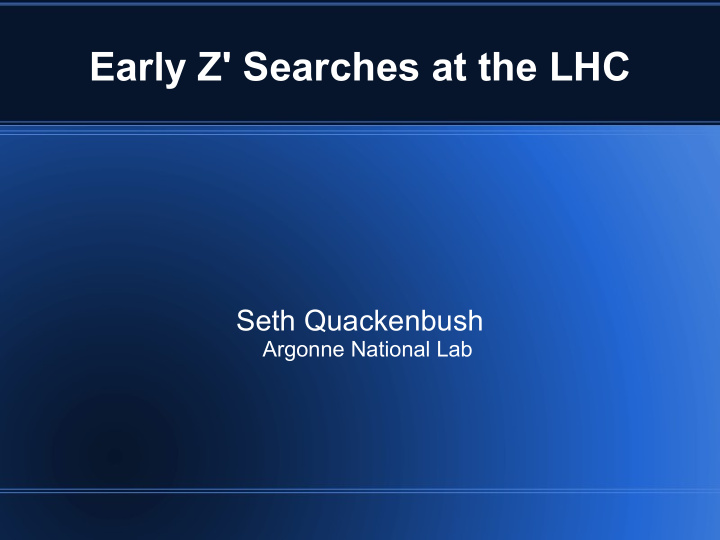



Early Z' Searches at the LHC Seth Quackenbush Argonne National Lab
Outline ● Motivation ● Signal ● Search reach ● Model parametrization ● Exclusion ● Future
Looking for a Z' ● A dilepton resonance is a clean signal, and a perfect place to look for new physics ● It could be a lot of things (experiments need to know what to look for) ● We (theorists and experimenters) need to know what can be found, what's ruled out, and if we find something, what it is ● This isn't a talk about favorite models—I don't have one ● Goal: get an idea where we'll be after first LHC run
Where to look ● Tevatron looked for resonances in electrons, muons, and jets (typical model hypotheses ruled out 500-1000 GeV) ● Z' is neutral, make with q q – Penalty for antiquark at LHC; suppresses Z', not QCD (no searching for dijets) ● That leaves dileptons (will discuss electrons, muons)
Mind your e's and μ 's ● Both great search channels (great resolution, clean) ● Look for generation-dependent models ● Most models still generation-independent; check sanity
Mind your e's and μ 's ● Both great search channels (great resolution, clean) ● Look for generation-dependent models ● Most models still generation-independent; check sanity 3.8σ excess!
Mind your e's and μ 's ● Both great search channels (great resolution, clean) ● Look for generation-dependent models ● Most models still generation-independent; check sanity 1σ?
Mind your e's and μ 's ● Both great search channels (great resolution, clean) ● Look for generation-dependent models ● Most models still generation-independent; check sanity Nada...
Search Reaches ● Usual benchmarks can be discovered in first few 100 pb -1 through more than 1 TeV (past Tevatron) ● Searches shape dependent—narrow width models show up early, large width degenerates into counting experiment
Search Reaches CMS, 7 TeV ● Usual benchmarks can be discovered in first few 100 pb -1 through more than 1 TeV (past Tevatron) ● Searches shape dependent—narrow width models show up early, large width degenerates into counting experiment
Assumptions, assumptions ● Want a measure of LHC capabilities without too many assumptions ● There are more models on heaven and earth... ● Even usual benchmarks (E 6 GUTs) have free parameters, like overall coupling (or mixing between multiple U(1)) ● There are lots of other models, some even motivated to be at LHC scale (Little Higgs, RS) ● Generic model will require new exotic fermions— invisible decays, affects leptonic branching fraction
Parametrize models ● Z' peak cross section goes like (spin 1 case) d dY = ∑ q c q a 1 q = u ,d M Z ' c q = q R 2 q L 2 e R 2 e L 2 = q R 2 q L 2 Br Z ' l l Carena et al. 24 Z ' Even interference terms negligible for early searches ● Coefficients only depend on mass, PDFs, cuts ● Invert data to bound coupling combination – Works for almost every model
3 Events ● Basically zero DY background if you go far enough in invariant mass ● If 3 events expected, fluctuates to zero 5% of the time – 95% exclusion if your model predicts 3 or more events in a bin – Robust against bin size (and thus model assumptions), just pick large enough bins to contain anything you would call a Z' ● I picked 10% of mass as a demonstration
Start excluding parameter space ● Typical models somewhat improved over Tevatron at 7 TeV for first 100 pb -1 , large improvement at 1 fb -1 ● Large masses with reasonable couplings completely inaccessible by Tevatron
The future Li, Petriello, SQ ● Measure couplings! Let's figure out what that resonance is! (Need lots more data)
Summary ● A Z' is more than a signal if it exists ● Even 7 TeV LHC will extend our knowledge significantly ● Model-independent bounds are ideal ● We will need more time to figure out what it is, but it will happen
Tevatron circa 2011
Recommend
More recommend